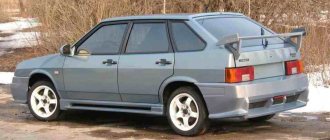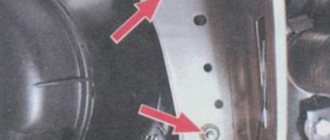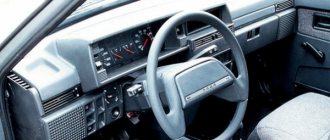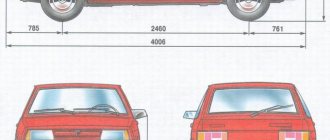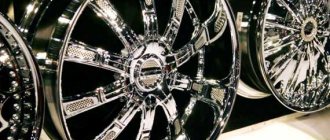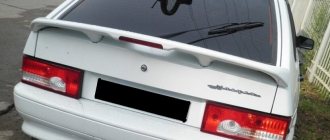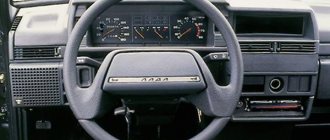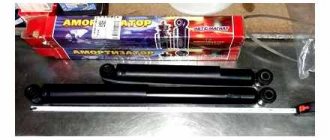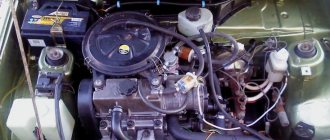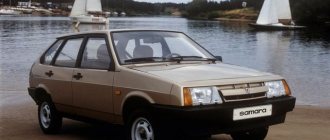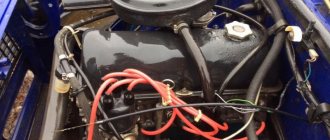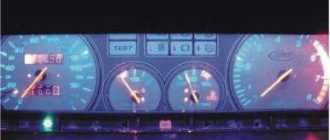Greetings, dear reader or car guest!
It was evening, there was nothing to do, and suddenly, out of the blue, it hit my head: I should write about the salons, figure out how many salons the first chisel family visited? What happened and when, what shades and colors are inherent in this or that year, etc.
Let's first look at the very first years of production of the VAZ-2109 model. Go:
Coming out after 2108, “Nine” received a light brown interior, or in common parlance, a “brown” interior. According to my observations, the color of the seats themselves could be a regular light brown color, like this:
Or a little yellowish, like in this photo:
The color of the door cards did not differ from the color of the seats, everything was the same color. The panel elements were also monochromatic, but the steering wheel could be either the same color as the panel, or dark-dark brown, almost like chocolate. The interior plastic was also brown, with the exception of the sill trim and rear shelves. Now we all ooh and ahh over brown interiors, but thirty years ago in the magazine “Behind the Wheel,” and most of the Soviet motorists thought differently:
The introduction of a gray interior and a dark dashboard finally satisfied the needs of those who resented the “dirty brown shades”. It was in 1989 that the so-called “Grey Salon” began to appear. This definition, as it were, “crushes” a different range of gray colors, for example, here is one example of a dark gray interior:
And here is another gray interior, but this time a light gray color:
And one more, but with a slight tint of blue in the door cards:
Also, in addition to gray, there were other more pleasant colors, red (raspberry), dark blue, but unfortunately these interiors were installed for essentially a year and not on all cars. The panel could be either dark gray, plain, the steering wheel was mostly the same color as the panel, although a couple of times I noticed advertisements for the new nines from 1989, and a dark brown steering wheel was installed there. I suspect that there were slight interruptions in the supply of new steering wheels. In 90-91, you could get a car with a completely black panel, a black steering wheel, and could have either a dark or light gray interior.
During this period of time, in principle, no special changes occurred in the interior of the 09 family, but there are some points that I would like to focus on. At the very beginning of the 90s, they were preparing for release of a new and updated model: VAZ-21099 and VAZ-21093. It was supposed to install a high panel, along with an electronic combination, trip computer, MPSZ, etc. This topic also affected the salon. New interior color schemes were created, which also did not go to the masses due to the beginning of turning points both in the history and in the economy of the former USSR and the new Russia. Here's an example:
But on the other hand, here is the interior of a 1992 car:
Also noticed in the advertisements was an interesting color of the seats, a car from 1993:
These years everything seemed to fall into place. Production continued, and salons began to sew the same colors, but again changing them over the years. We have already begun to install fabric inserts in door cards more often. The door cards themselves became the same color: dark gray with a slight hint of blue. If we talk about the panels, then some parts began to be made from low-quality material, which over time faded greatly in the sun and became disgusting green; they got rid of this sore only closer to 1999-2000.
VAZ 2109
“Nine” became a logical continuation of 2108. Its history of existence begins in 1986. The car appeared before buyers in the form of a hatchback with five doors, which significantly increased its utilitarian capabilities.
Engineers slightly changed the dimensions and proportions of the 2109 body relative to the Eighth model. In particular, it is worth noting the new sidewalls and less massive front doors, which deprived the car of its swift appearance, but made it possible to make the rear doorways of normal sizes.
VAZ 21099
The idea of creating a sedan based on the 2108/2109 models haunted the creators from the very moment they were launched into series. The fact is that in the USSR, even in the 80s, a car was still a luxury and the buyer preferred modern Samaras to the time-tested “classics”, which had a more spacious trunk and a comfortable interior.
In this regard, VAZ management constantly received letters from Soviet car enthusiasts demanding the release of a new sedan. In Togliatti they listened to these requirements and in 1990 launched the Lada 21099 into mass production.
Soviet motorists greeted the new product with undisguised delight. After all, it met all the necessary requirements at that time - the presence of a spacious trunk, as well as acceptable comfort due to two additional rear doors.
VAZ models and their colors
VAZ cars, which appeared to the world thanks to the decision of the CPSU Central Committee to build a new large automobile plant in Tolyatti, initially completely copied the models of the Italian concern Fiat. Some cars were even built by Italian specialists using their own technologies.
"Six"
One of the best models of the VAZ concern called “Six” still runs briskly along the roads of our country. Almost 40 years have passed since this car first came off the production line, but it is still very popular among motorists in the countries of the former CIS, and sells well.
Before we move on to describing the color of this car, let us remind you that the “six” is a 5-seat rear-wheel drive sedan. Over the entire history, which lasted until 2002, about 4 million units of this legendary car were produced.
The “Six” had many modifications. There were ten of them. At one time, they even produced a VAZ 2106 pickup truck and a right-hand drive “six” for countries with left-hand traffic.
| Color name | Code | Additionally |
| Eggplant | 107 | Dark purple color. |
| Amethyst | 145 | Silver violet metallic. |
| Primrose | 210 | Light yellow color. |
| Cappuccino | 212 | Light gray beige color. |
| Safari | 215 | Light beige color. |
| Golden beige | 109 | Golden beige metallic. |
| Success | 123 | Orange. |
| Cherries | 162 | Dark scarlet. |
| Pomegranate | 180 | Dark burgundy. |
| Flame | 193 | Dark red (from new colors). |
| White | 201 | White. |
| Snow white | 202 | Bright white. |
| Alpine | 205 | White metallic. |
| City | 231 | Golden brown (from new colors). |
| Gray-white | 233 | Grey-white. |
| Honey | 234 | Yellow-gold metallic. |
| Beige | 235 | Beige. |
| Gray beige | 236 | Grey-beige. |
| Antelope | 277 | Silver beige. |
| Cashmere | 283 | Dark brown. |
| Jam | 285 | Yellow-brown metallic. |
| South Cross | 290 | Grey-beige metallic. |
| Creamy white | 295 | Creamy white. |
| Silver willow | 301 | Silver-greenish-gray metallic. |
| Bergamot | 302 | Silver-green metallic. |
| Agave | 303 | Metallic green (from new colors). |
| Nautilus | 304 | Dark green. |
| Asparagus | 305 | Silvery light yellow metallic. |
| Avens | 306 | Olive. |
| Green Garden | 307 | Dark green. |
| Sedge | 308 | Green-blue metallic. |
| Currency | 310 | Grey-green metallic. |
| Iguana | 311 | Silvery bright green metallic. |
| Green tea | 312 | Green (from new colors). |
| Aquarius | 313 | Grey-green metallic. |
| Meridian | 317 | Green. |
| Duchess | 321 | Silver milky green metallic. |
| Moulin rouge | 458 | Bright purple. |
| Atlantic | 440 | Dark blue. |
| Moray | 377 | Blue-green. |
| Baltika | 420 | Blue-green. |
Design differences
What is the difference between 2109 and 21099?
Even though these two cars are very similar, there are still some differences between them.
So, 21099 had the following features:
- A different radiator grille configuration.
- Instrument panel with a tachometer (early versions).
- The rear overhang of the body has been increased by 20 centimeters.
Variations
VAZ 2109 and 21099 had modifications with identical technical characteristics.
Therefore, it is more logical to present only the power units with which these models were equipped:
- The engine is 1.3 liters with an output of 64 horsepower.
- The engine is 1.5 liters, producing 70 horsepower.
- Installation of 1.5 liters with fuel injection system. Develops 78 “horses”.
All engines were equipped with a five-speed manual transmission.
Salon
Tuning the VAZ 21099 also applies to interior modifications. First of all, they change the standard sound insulation, upholstery, seats and instrument panel.
To improve the sound insulation properties, the interior is emptied, the trim is dismantled and noise-reducing materials are attached using a special adhesive, and the joints are treated with appropriate liquid solutions. The new upholstery gets better materials, and the standard seats are replaced with ones removed from foreign cars.
Improvement of the dashboard consists of installing a multimedia center (a tablet computer integrated into the dashboard of the car), installing an on-board computer, and a navigator. The instrument panel and steering wheel installed on a tuned VAZ 2109 can also be removed from another model.
About the preferences of motorists
Owner reviews of these cars differ little from each other. The models are structurally similar and have the same disadvantages. The main ones are severe corrosion of the body, as well as an interior that rattles on uneven surfaces.
Many people do the tuning themselves. The improvements, for the most part, concern minor changes in the appearance and interior. An example of tuning can be easily found on the Internet - read the relevant articles or watch a video.
Chassis
Improving the car's chassis involves tuning the suspension and refining the braking system. The transmission and engine of the VAZ 2109 are also undergoing changes.
Engine
Engine tuning is aimed at increasing the power of the power unit. Refinement of the engine consists of improving the cylinder head, replacing pistons, and installing a turbine. When performing these modifications, the driver will need to completely disassemble the vehicle engine.
Changes in the engine design give the car additional power. However, in order for the car to be used, all modifications made must be registered with the traffic police.
When tuning a carburetor, instead of one part, install two and grind the carburetor intake manifold.
Suspension
Tuning the VAZ 2109 suspension is aimed at increasing its rigidity, for this:
- The parts are being replaced with more modern ones. For example, by purchasing a gas-oil shock absorber from a well-known manufacturer, the driver will improve the functioning of the rear and front suspension.
- Installation of elements that provide additional rigidity to the suspension. These may be stiffer springs from other models.
- Installation of a pneumatic mechanism that allows you to independently adjust the car's ground clearance. The installation process of such a system is labor-intensive and expensive.
After the work done with the suspension, the car will be more predictable and stable when cornering.
Transmission
Tuning a VAZ 21099 also involves changing the design of the car’s suspension. Drivers change the number of gear ratios, focusing on their driving style, and install a short-throw rocker. This increases the speed of gear shifting.
In case of independent tuning, if there are errors, the gearbox may function unstable, which will lead to emergency situations on the road. Therefore, to improve the operation of the VAZ 2109 gearbox, it is recommended to contact a service center that is equipped with the appropriate equipment.
Brakes
To tune a VAZ 2109 car, it is recommended to improve the brakes. Models produced at the Volzhsky Automobile Plant were equipped with rear drum brakes. To improve the braking properties of the car, drivers change them to disc ones.
When replacing brakes, the hubs are also replaced. For example, when installing disc brakes on a car, wheel hubs from a VAZ 2112 are mounted.
VAZ 2109 is a Soviet and Russian passenger car that is extremely popular in Russia and the CIS countries. The model has a low price, which makes tuning affordable. Improving the driving performance of the Nine and its appearance makes it possible to get a comfortable, beautiful and stylish car for relatively little money.
Trial
Nothing extra
These two cars look quite attractive. Their design is devoid of provocative solutions, but it is harmonious and thoughtful. “Nine” has a more rapid body profile, while 21099 is more sedate and respectable.
In terms of geometric cross-country ability, the 2109 has a slight advantage due to shorter body overhangs. But driving over potholes on the 21099 is more problematic due to the long stern.
Comfortable and cozy
The interior of both Samaras is identical. It is worth mentioning in advance that the quality of finishing materials is far from ideal - hard, echoing plastic everywhere. Of course, plastic made it possible to reduce the weight of cars, but it deprived VAZ models of that touch of luxury for which the Zhiguli of the classic family is famous. At the same time, the ergonomics are good and you don’t have to be distracted from the road thanks to the compact layout of the controls.
Elastic front seats provide good body support. However, a tall driver will complain about the lack of adjustment of his seat in the longitudinal plane. Only two passengers are comfortable on the back seat, provided their height is less than 175 centimeters.
As for the luggage compartment, there are differences between 2109 and 21099. The “Nine” has a trunk volume of 270 liters, while its more practical companion platform has this figure already equal to 400 liters.
